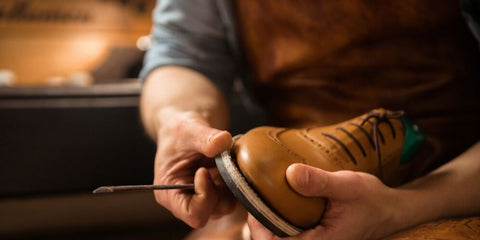No Products in the Cart
- FREE DELIVERY ON ALL ORDERS ABOVE 5000/- PKR.

The art of crafting leather shoes is as old as civilization itself.
From the durable Caligae worn by Roman soldiers to the stylish trends sported by today’s fashion-forward individuals, leather footwear has stood the test of time. Whether it’s multi-billion-dollar global brands or niche local startups, the shoe crafting process largely follows time-honored methods—blending form, function, and tradition.
In this blog, we take you behind the scenes at Moriox Shoes to uncover the secrets of our craftsmanship. You’ll get a close look at our materials, methods, and the time-honored techniques that go into every pair.
We’ll also explore traditional shoe-making techniques, artisanal craftsmanship in leather footwear, and the process of shoe production that results in our signature handcrafted leather shoes.
One of the most common questions we receive is: “What is the process of making leather shoes?”
At Moriox Shoes, the answer lies in our meticulous attention to every step: from the initial concept to the final polish.
Here’s how we bring your favorite shoes to life:
Designing: Every pair begins with a vision. Designers sketch ideas that balance aesthetics, comfort, and utility.
Pattern Making: We develop templates for the upper, lining, sole, and other parts.
Cutting: Skilled hands cut the leather with precision.
Stitching: The shoe begins to take form as the upper parts are stitched together.
Lasting: The stitched upper is shaped on a mold (called a last).
Finishing: The final touches—like polishing, trimming, and labeling—complete the masterpiece.
This shoe-crafting process is essential to ensuring quality, consistency, and character in every pair.
What is the raw material for leather shoes? It starts with tanned leather sourced from goats, buffaloes, and camels—each offering unique textures and durability. Our tools include:
Scissors and cutters: For shaping leather into precise patterns.
Customized chisels: Used to add decorative or functional details.
These tools allow us to create everything from sleek formal footwear to stylish casuals.

Not all leather is created equal.
At Moriox Shoes, we select our materials based on the specific shoe design and its intended use.
The most commonly used types include:
Calfskin: Known for its softness and fine grain—perfect for dress shoes.
Goat skin: Lightweight and breathable, ideal for casual wear.
Lambskin: Luxurious and ultra-soft, often used in high-end collections
We often use full-grain leather, especially in wedding and corporate shoes, for its unmatched strength and elegance.
At Moriox Shoes, we honor traditional shoe-making techniques that have stood the test of time. Some of these include:
One of the oldest methods, this involves sewing the upper to the sole and then turning the shoe inside out—hiding the seam and enhancing flexibility.
Renowned for its durability and ease of repair, this technique involves stitching the upper to a welt, which is then securely attached to the sole—making it a staple in high-end formal footwear.
An artisanal technique where the welt is sewn by hand to both the upper and the sole. It’s labor-intensive but results in extremely durable and elegant shoes.
Blake-Stitched Construction: Offers a sleek profile and lighter feel
Cemented Construction: Used for casual or athletic shoes.
Storm/Norwegian Welt: Designed for extreme weather durability.
Each method reflects a different balance of tradition, performance, and design.

Artisanal craftsmanship in leather footwear is more than just a technique—it’s a philosophy. At Moriox Shoes, we blend heritage skills with modern aesthetics. Our artisans carefully choose premium top-grain leather and handcraft each piece to highlight the material’s natural character.
Unlike mass-produced shoes that often use synthetic components, our handcrafted shoes boast timeless elegance and exceptional comfort. Every stitch, fold, and finish is a testament to human skill and artistic dedication.
So, what goes on behind the closed doors of our workshop?
Let’s walk you through each step of shoe production at Moriox Shoes
Our designers start by analyzing market trends and customer preferences. They then develop sketches and tech packs detailing everything from materials to stitching patterns.
We source high-quality leather, textiles, and rubber. These are then cut, printed, and laminated based on the shoe’s blueprint.
This involves:
Stitching together the cut components to create the upper.
Attaching the upper to a last for shaping.
Fixing the outsole and adding structural elements like insoles.
Stitching the welt (if applicable).
The shoes are polished, cleaned, and detailed. Branding elements like embossed logos or metal tags are added here.
Every pair undergoes strict inspection to ensure perfection—flaws are corrected or discarded.
Finally, the shoes are boxed and labeled for shipment. Whether you’re a retail partner or an online customer, your pair arrives ready to impress.
We believe that true luxury lies in craftsmanship, not in price tags.
Our commitment to heritage methods, premium materials, and passionate artisanship results in footwear that tells a story. Whether it’s a wedding, office meeting, or casual hangout—you’ll find a pair that fits not just your feet, but your lifestyle.
From the first sketch to the final polish, crafting a quality leather shoe is a labor of love. In this blog, we’ve walked you through the entire journey—from materials and techniques to the actual making process at Moriox Shoes.
We’ve uncovered the essence of handcrafted leather shoes,shared insights into shoe production, and highlighted the value of traditional shoe-making techniques.
Ready to step into a new level of style and comfort? Browse our collection today and find the perfect pair. But don’t wait—our bestsellers tend to walk off the shelves quickly!